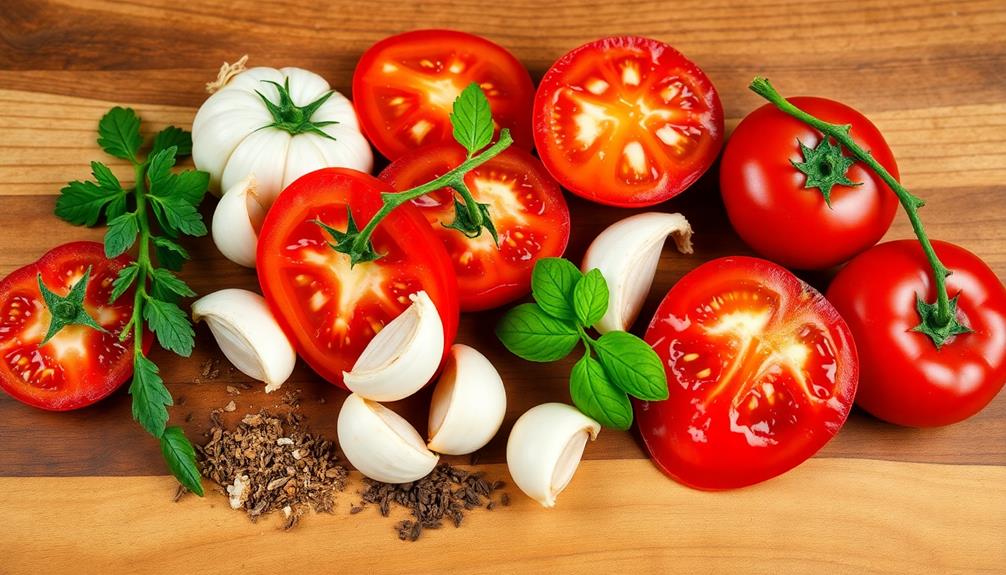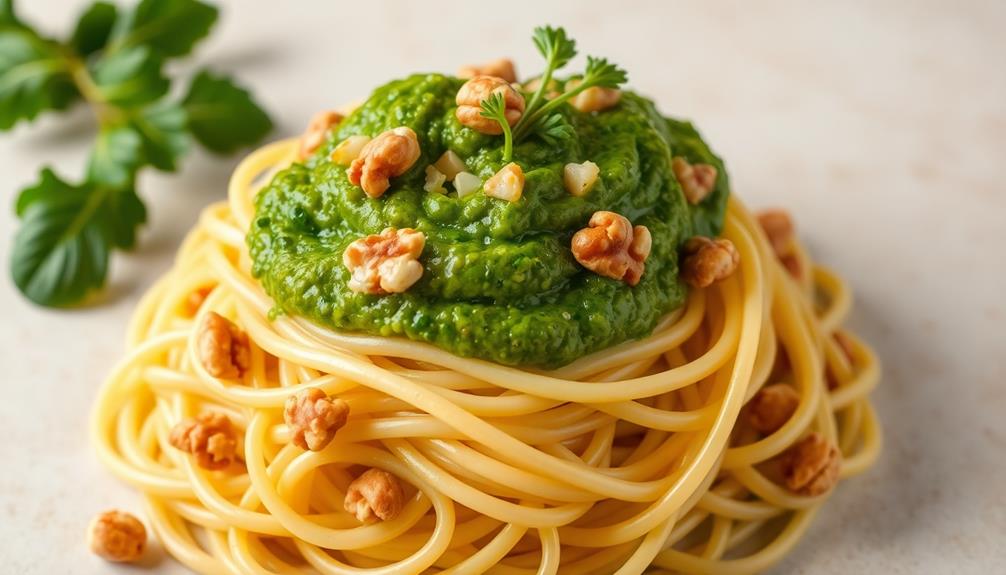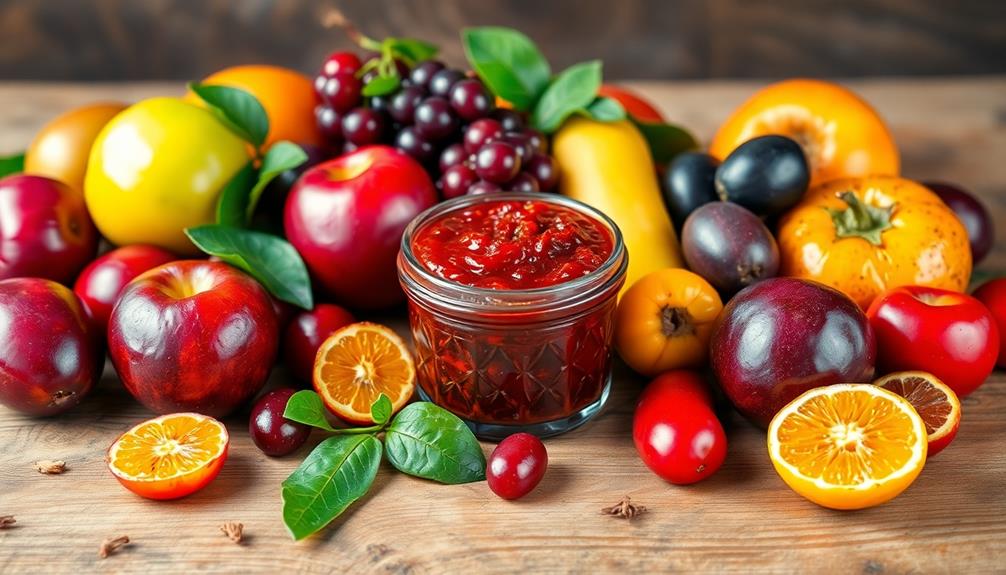If you're looking for a zesty and vibrant way to spice up your meals, you've got to try chimichurri – the mouthwatering Argentinian green sauce! This flavorful condiment has a long and storied history, originating from the gauchos (skilled horsemen) of the Pampas. It's made with fresh parsley, garlic, olive oil, and a splash of tangy vinegar, creating a bold taste that'll have your taste buds dancing. You can use chimichurri as a marinade, topping, or dipping sauce for all sorts of dishes, from juicy grilled meats to roasted veggies. And the best part? It's super easy to make at home. Want to learn more about this zesty sensation?
Key Takeaways
- Chimichurri is a traditional Argentinian green sauce made primarily with fresh parsley, garlic, olive oil, and red wine vinegar.
- The sauce originated with gauchos, skilled horsemen and ranchers of the Pampas, and has evolved with regional and familial variations.
- Chimichurri has a bold, zesty flavor profile, enhanced by the fresh herbs and tangy vinegar, and can vary in consistency from pourable to paste-like.
- The sauce is versatile, commonly used as a marinade for grilled meats, a topping for steak or chicken, or a condiment for various dishes.
- Chimichurri is rich in antioxidants and healthy fats, and its simple preparation makes it an accessible and flavorful addition to many meals.
History
Chimichurri, the vibrant green sauce, has a rich history rooted in the culinary traditions of Argentina.
It's believed that the sauce originated with the gauchos, the skilled horsemen and ranchers of the Pampas region. These hardworking cowboys would whip up this zesty condiment to add flavor to their grilled meats, using ingredients they'd on hand like parsley, garlic, and olive oil. As the tradition of the chimichurri sauce spread to other parts of South America, variations emerged, with some incorporating cilantro or vinegar for a tangy kick. Many modern versions also include red pepper flakes for a touch of heat. Some chefs even use chimichurri as a marinade or dipping sauce for bread. If you’re looking for a refreshing twist on the classic chimichurri, you can try incorporating it into a gazpacho recipe for a unique and flavorful soup option.
Over time, the recipe evolved, with each family and region putting their own unique spin on the classic chimichurri. Some might add a splash of vinegar for tanginess, while others might experiment with different herbs like oregano or cilantro.
No matter the variation, chimichurri has become an integral part of Argentine cuisine, a reflection of the country's vibrant culture and the ingenuity of its people.
Today, this iconic green sauce is enjoyed not just in Argentina, but all around the world, bringing a taste of the Pampas to kitchens everywhere.
Recipe
Chimichurri is a vibrant and flavorful green sauce that originated in Argentina. It's a versatile condiment that can be served with a variety of meats, grilled vegetables, or even as a dip. The combination of fresh herbs, garlic, and a tangy vinegar creates a bold and zesty flavor profile that perfectly complements many dishes.
Traditionally, chimichurri is made with parsley as the primary herb, but other herbs such as oregano, cilantro, or even basil can be used to create a unique twist on the classic recipe. The sauce's consistency can range from a loose, pourable liquid to a thicker, more paste-like texture, depending on personal preference and the intended use.
- 1 bunch fresh parsley, finely chopped
- 3 cloves garlic, minced
- 1/2 cup olive oil
- 2 tablespoons red wine vinegar
- 1 tablespoon dried oregano
- 1 teaspoon crushed red pepper flakes
- 1/2 teaspoon salt
- 1/4 teaspoon black pepper
In a medium bowl, combine the chopped parsley, minced garlic, olive oil, red wine vinegar, dried oregano, crushed red pepper flakes, salt, and black pepper. Stir the ingredients together until well combined. Adjust seasoning to taste.
For best results, allow the chimichurri to sit for at least 30 minutes before serving to allow the flavors to meld. The sauce can be stored in an airtight container in the refrigerator for up to 1 week.
When ready to use, stir the chimichurri to redistribute the herbs and oil. Enjoy the versatile chimichurri on grilled meats, roasted vegetables, or as a dipping sauce for crusty bread.
Cooking Steps
First, you'll want to finely chop the parsley and oregano.
Then, add a bit of lemon juice and olive oil to bring everything together.
Don't forget to mix in the garlic and chili peppers – they'll give your sauce a real kick!
Finally, season with salt and pepper to taste, giving it a good stir.
Yum, your Argentinian green sauce is almost ready to enjoy!
Step 1. Finely Chop Parsley and Oregano

Although the key ingredients for chimichurri are parsley and oregano, you'll want to finely chop them to create the perfect texture for this Argentinian green sauce.
Start by gathering a sharp knife and a clean cutting board. Gently grasp a bunch of fresh parsley, stems and all, and place it on the board. Slowly and carefully, begin chopping the parsley, working your way from the top of the leaves down to the stems. Move the knife in quick, even motions to create a fine, consistent chop.
Once the parsley is done, repeat the process with the oregano, snipping off any tough stems before chopping. The key is to mince both herbs until they're almost a paste-like consistency. This helps the flavors meld perfectly in the chimichurri.
With the parsley and oregano prepped, you're one step closer to enjoying the bright, bold taste of this classic Argentinian condiment.
Step 2. Add Lemon Juice and Olive Oil

With the parsley and oregano now finely chopped, it's time to add the next key ingredients – lemon juice and olive oil. Squeeze the fresh lemon juice right into the bowl, letting the tangy citrus scent fill the air.
Next, drizzle in a generous amount of aromatic, golden olive oil. The lemon and oil will combine to create a smooth, flavorful base for your chimichurri sauce.
Stir everything together with a fork or spoon, making sure the parsley and oregano are evenly coated. You'll notice the mixture starting to transform, becoming more vibrant and fragrant.
The lemon juice adds a bright, zesty zing, while the olive oil lends a rich, silky texture. Keep mixing until the chimichurri has a nice, cohesive consistency – not too thick, but not too thin either.
Now your sauce is ready for the final touches that will make it truly irresistible!
Step 3. Add Garlic and Chili Peppers

Next, mince the garlic cloves and slice the chili peppers. You'll need about 3-4 cloves of fresh garlic – don't be stingy! Mince them up nice and small so they'll blend right into the sauce.
As for the chili peppers, you can use whatever kind you like best. Jalapeños, serranos, or even milder bell peppers will all work great. Just slice them into thin rounds and add them to the mix.
The garlic and chili peppers are what really give chimichurri its signature bold, zesty flavor. You'll want to add them to taste – start with a little and add more if you want an extra kick.
The chili peppers will lend some heat, while the garlic provides an aromatic punch. Together, they complement the fresh herbs and acidic lemon juice perfectly.
Stir everything up and get ready for your taste buds to be tantalized!
Step 4. Season With Salt and Pepper

Now that you've added the punchy garlic and chili peppers, it's time to season the chimichurri with salt and pepper.
Grab a pinch of each and sprinkle them over the vibrant green mixture. The salt will help enhance all the fabulous flavors, while the pepper adds a delightful kick.
Go ahead and give it a good stir, making sure the seasonings are evenly distributed. You'll love how the pungent garlic, fiery chili, fresh herbs, and now the savory salt and pepper come together in perfect harmony.
It's like a party in your mouth! Keep tasting and adjusting the seasoning until it's just right. The right balance of flavors is crucial for an authentic and utterly delicious chimichurri.
Soon, you'll have a zesty, well-seasoned sauce ready to drizzle over all your favorite dishes.
Step 5. Stir and Adjust Seasoning to Taste

After seasoning the chimichurri with salt and pepper, give the mixture a good stir to ensure the seasonings are evenly distributed.
You'll want to make sure every bite of your chimichurri packs a punch of flavor! Grab a spoon and give it a good mix, making sure to scrape the sides and bottom of the bowl.
Smell that amazing aroma? Mmm, it's making your mouth water, isn't it?
Now, take a small taste and see how it turned out. Does it need a bit more salt or pepper? Or maybe it's perfect just the way it is!
Use your taste buds to guide you – you're the chef, so you get to decide. Keep stirring and tasting until the seasoning is just right.
Once you're satisfied, your chimichurri is ready to be drizzled over your favorite grilled meats, fish, or vegetables.
Get ready for an explosion of flavor in every bite!
Final Thoughts
Ultimately, chimichurri is an exceptionally versatile green sauce that can elevate a variety of dishes.
Whether you drizzle it over steak, chicken, or fish, its bold flavors will instantly make your meal more exciting. You can even use it as a marinade or dip for crusty bread – the possibilities are endless!
What's more, chimichurri is a breeze to make. With just a few simple ingredients like parsley, garlic, and olive oil, you can whip up a batch in no time.
The best part? This sauce packs a punch, so a little goes a long way.
Frequently Asked Questions
Is Chimichurri Only Used for Grilled Meats?
No, chimichurri isn't only used for grilled meats. You can use it as a dipping sauce, marinade, or topping for all kinds of dishes, from roasted vegetables to fish and chicken. It's a versatile green sauce.
Can I Make Chimichurri Ahead of Time?
You can absolutely make chimichurri ahead of time. It'll stay fresh for up to a week in the fridge, allowing you to have the flavors develop and have it ready to go when you need it.
How Long Does Homemade Chimichurri Last in the Fridge?
Homemade chimichurri can last 3-5 days in the refrigerator if you store it properly. Make sure to keep it in an airtight container and avoid letting it sit at room temperature for too long.
Can I Use Dried Herbs Instead of Fresh?
You can use dried herbs instead of fresh, but the flavor won't be as vibrant. Dried herbs have a more concentrated taste, so you'll need to adjust the measurements accordingly. Start with less and add more to taste.
What Is the Best Way to Store Leftover Chimichurri?
To store leftover chimichurri, place it in an airtight container and refrigerate it. It'll keep for up to a week. You can also freeze it for longer storage, just be sure to thaw it before using.









